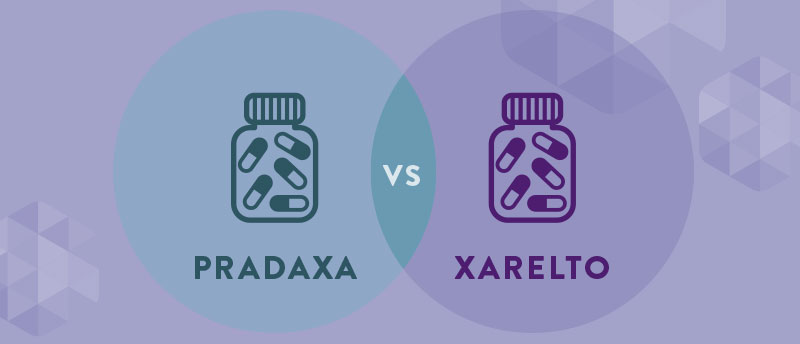Pradaxa vs Xarelto: Comparing the New Class of Blood Thinners

Until the last decade, the only option available for patients with nonvalvular atrial fibrillation to help control blood clots was Coumadin (also known as warfarin). While effective in preventing intracranial bleeding, patients on Coumadin have to endure regular blood tests and risk major bleeding complications. Now there are new drugs known as non-vitamin K antagonist oral anticoagulants (NOACs).
The two anticoagulants at the forefront of the market are Pradaxa (dabigatran), made by Boehringer Ingelheim, and Xarelto (rivaroxaban), manufactured by Johnson & Johnson's Janssen Pharmaceuticals division. Both of these blood thinners are considered by some doctors to be safer and more effective than Coumadin. But they still come with increased risk of severe bleeding that have resulted in patients filing both Xarelto lawsuits and Pradaxa lawsuits by the thousands. Additionally, they are more expensive and may impact the renal system with prolonged use.
Because of these issues, we decided to do a head-to-head comparison between the two biggest rivals in this class of new blood thinners. Patients trying to choose the right blood thinner should consider the following things when weighing their options.
The Bleeding Risk of New Blood Thinners
What is the best blood thinner? Despite being safer than Coumadin, both Xarelto and Pradaxa have potentially deadly side-effects. The major concern with any blood thinner is the possibility of internal bleeding. Blood-thinning medications are great at stroke prevention, as well as decreasing the risks of deep vein thrombosis and emboli. But that also means that your blood may not be able to clot when it really needs to. Both Xarelto and Pradaxa are the targets of major lawsuits because hemorrhages which have hospitalized or killed thousands of patients.
Pradaxa: Until recently, Pradaxa also had no antidote; however in 2015 a reversal agent called Praxbind was approved by the FDA to stop the effects of Pradaxa in emergency situations. About 80% of Pradaxa is removed from the body via the kidneys. If you have kidney problems and are prescribed Pradaxa, it is likely the 75mg dose, rather than the standard 150mg dose. The 75mg is less effective at preventing hemorrhagic stroke, pulmonary embolism and other clotting issues.
Xarelto: Unfortunately, Xarelto has no antidote to help clotting factors when a serious bleed occurs, and specifically carries an increased risk of gastrointestinal bleeding. So if you are unable to clot on your own, there's not much doctors can do to help. Although both of these medications are processed in part by the kidney, only about 33% of Xarelto goes through the renal system. The low dose of Xarelto (which comes as 10, 15 or 20mg) does not seem to have as much of a deficit in effectiveness. So, for people worried about their kidneys, Xarelto may be the right choice.
Other side effects of both drugs including nausea, bowel issues (such as irritation, bloody stool or constipation), and bruising are listed for both medications. Neither is safe for pregnant women. Both may interact with other medications, including NSAIDS, HIV/AIDS medications and others.
Pradaxa and Xarelto are Expensive
One good thing about Coumadin is that there is a generic version available. Even with the monthly blood tests, which can be self-administered or done at a doctor's office, the cost for Coumadin is significantly lower than for Pradaxa or Xarelto. Pradaxa and Xarelto do not have generic options and are both expensive. Without private health insurance or Medicare, the annual cost of thee drugs could be upwards of $5,000 (about $435 for a month's supply).
Xarelto boasts "the lowest out-of-pocket" costs in its class on its website, but it does not provide any solid numbers for copays.
Xarelto is a Convenient Drug
The option for an oral pill was a huge convenience boost for patients previously on Coumadin. If that's your main focus as a patient (or a caretaker), the winner here is Xarelto. This is purely because Xarelto is a once-daily pill, while Pradaxa must be taken twice a day.
A study in the Journal of the American Pharmacists Association reported that in one year, 9 million hospital admissions and as many as 18 million emergency room visits were the result of incorrect use of medications. This includes everything from missed doses, overdosing, accidental interactions, or a lack of understanding as to how the drug should be used.
For elderly patients, especially those who may already have suffered a stroke or other mentally-impairing event, physicians may choose Xarelto because it only requires one pill a day. This greatly lessens the possibility of accidentally forgetting a dose, which can increase stroke risk or cause a heart attack if not properly rectified.
Other Blood Thinner Options
If none of Coumadin, Xarelto and Pradaxa are right for you, remember that there are always new anticoagulants coming to the market. Most recently, Eliquis (apixaban) has made a splash in the industry. A twice-daily pill, Eliquis is considered much safer for patients with renal issues without requiring lower, less effective dose. In fact, a recent meta-analysis of 94,656 patients published in the BMJ found that Eliquis was the top choice when accounting for comparative effectiveness, safety and cost altogether.
Of course, there are always the old standbys of warfarin and aspirin. While these drugs have their own issues, at least they are well known in the medical community and have been used for decades. And if something goes wrong while taking them, it is easier to reverse their effects than with some of the newer drugs.
Be sure to talk with your doctor before beginning or switching any medication. If you have concerns about your blood thinner choice, they can walk through your particular circumstances, and give appropriate medical advice. Or, they can help you find a better fit! With any medication, it's important to be informed; that way you can be confident that you are making the healthiest choices for your body.
